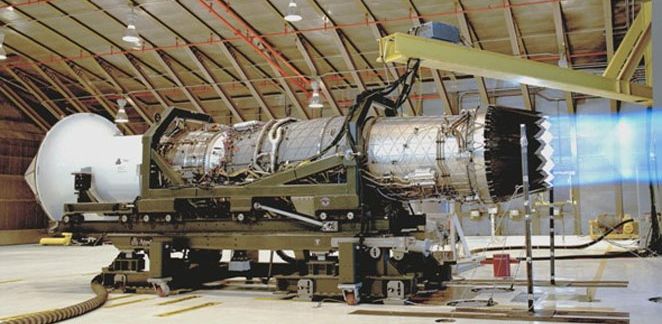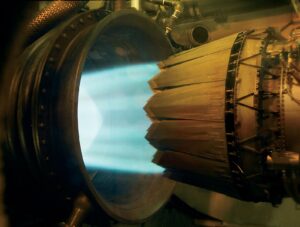
Many F135 engines built by Pratt & Whitney will be heading to the depot for maintenance in 2023. (File)
MIDDLETOWN, CT: Pratt & Whitney, the company that manufactures the engine for the F-35 stealth fighter, has a big, costly problem — and no easy solution in sight.
In the mid-2020s — just as the Pentagon expects to see a sharp decrease to F-35 sustainment costs — the first F135 engines used by the jet will hit 2,000 hours and will be sent to the depot for a scheduled overhaul.
While the company is taking steps to minimize the cost of that maintenance work as much as possible, it’s unavoidable that engine sustainment costs will bump up during the mid-2020s, said Amanda Glode, Pratt & Whitney’s director of sustainment for the F135.
That, in turn, will make it more difficult for the F-35 program to meet a longtime goal: reducing the cost per flight hour to $25,000 by 2025.
“If we think about the lifecycle cost of a program, sustainment is the largest portion of that lifecycle cost, and scheduled maintenance is the largest portion of that sustainment cost,” Glode told reporters Tuesday.
“We’re just in a different part of the lifecycle of the program than the rest [of the program] is,” she said. “Unfortunately our costs are going to be increasing” in the mid 2020s, “as we increase our scheduled maintenance at the exact point that the US services and the entire program want the costs to be decreasing.”
Explaining that reality to F-35 program stakeholders — which include the US Air Force, Navy and Marine Corps, a host of international customers, and skeptical lawmakers on Capitol Hill — has been a challenge for the company, said Glode.
Pratt & Whitney invited reporters to its F135 production plant in Middletown, CT., on Tuesday, hoping to shift the narrative around the F135’s cost and performance.
Throughout the tour of the facility, officials from Pratt consistently stressed that the upcoming cost increase wasn’t the company’s fault. Instead, they pointed fingers at unexpected wear and tear due to operational usage, inconsistent funding of spare parts, repeated delays in standing up maintenance depots, and the normal churn of engine overhauls, which typically ebb and flow as engines meet usage milestones.
And while those are all justifications based in reality, that messaging likely will face skepticism from both members of Congress and Pentagon officials who want to get costs down on the famously over budget program, regardless of where it comes from.
Earlier this year, the Pentagon disclosed the F-35 enterprise was facing an engine shortage, leading some lawmakers to suggest that the Defense Department should open a competition for more advanced engines to replace the F135. But while Congress may want a magic bullet solution, the engine shortage issues are multifaceted and not easily resolved.
First, the F135 Heavy Maintenance Center at Tinker Air Force Base, Okla., has not been able to repair power modules as quickly as projected, creating a backlog of work. Secondly, some aircraft that frequently operated in hot, sandy environments were grounded after the coating on engine rotor blades cracked and degraded.
Pratt & Whitney has developed a new coating that has been incorporated on about 25 percent of the F-35 fleet — mostly jets that have recently rolled off the production line. But it could take as long as 2030 for all fielded jets to be retrofitted, said Katherine Knapp Carney, the company’s chief engineer for the F135 program.
Lt. Gen. Eric Fick, who leads the F-35 program on behalf of the government, told lawmakers in July that 41 F-35As flown by the US Air Force were down and awaiting engine repairs, with an additional five other F-35s also inoperable due to engine-related problems.
Three months later, there has been little improvement: As of Friday, the number of Air Force F-35As grounded due to propulsion issues stood at 42 jets, according to an Air Force source with knowledge of the program.
Glode acknowledged that the current F135 sustainment strategy clearly isn’t meeting customer needs, and that Pratt & Whitney needs to make improvements in the area of affordability. However, the company is meeting program requirements when it comes to the number of F-35s down for engine issues, she said.
Under its current contract, Pratt & Whitney is obligated to ensure that no more than 10% of F-35s are down due to engine issues, with 6% being the objective number. Historically, the company has “beat” the objective number, with only 4% of the fleet typically non-mission capable because of engine problems.

The F135 engine seen during a test. (File)
With about 9% of jets currently down due to engines, Pratt & Whitney is still technically within threshold levels of its agreement with the Pentagon, even if it’s not meeting the objective, Glode said.
“That’s a lot of the challenge that we get into today, is people not appreciating the fact that this was the way the program was designed,” she said.
“We’re very comfortable working in any construct that the customer requires, and certainly we’ve been encouraging the [Pentagon’s F-35 joint program office] to work with the partners and services to try and understand what ‘good’ looks like and how they want to change the program,” she said. “We hear and we understand the feedback that what is executed today is not satisfying, but we can’t go and change the program ourselves.”
Even if money flows to expedite work at the F135 depot at Tinker, to stand up additional maintenance hubs elsewhere, to buy additional engines and to change the F135 sustainment architecture, it will take time for those changes to take effect and for the engine backlog to subside, Glode said.
“The depot network is about five years behind in terms of where it should have been based on the program design and architecture, in large part because funds were diverted earlier in the program because there were other needs,” she said. “Sustainment just didn’t get the budget that it required in a timely manner.”
Future Hopes
There are some signs of improvement at the depot, said Jen Latka, Pratt & Whitney’s vice president for the F135 program.
Tinker’s depot only produced 14 power modules last year, but is on track to “significantly” exceed its target of 40 modules in 2021, she said. And while it took more than 200 days on average to repair a power module in 2020, workers on the depot have begun to hit the “aggressive and realistic” 120 day target that will remain the goal for the future.
The pressure on the depot will be even higher once engines begin coming in for scheduled overhauls in 2023, so Pratt & Whitney is trying to take steps now so that future work can occur as quickly and affordably as possible, officials said.
For the F135 — which has rotors made of titanium and artisan-made components measured to the thousandth of an inch — the biggest drivers of cost during maintenance events are parts and materials, Latka said. Therefore, Pratt & Whitney’s focus has been on conducting engineering work and developing repairs that enable maintainers to replace fewer parts during overhauls.
“It’s not about labor,” she said. “That is not going to move the needle in terms of cost reduction on the engine.”
Another long-term effort is making continual improvements to parts and managing the fleet so that engines can stay on wing for longer periods of time without having to be sent to the depot for scheduled or unscheduled repair work, said Glode.
However, she noted that there will be added costs in the mid-2020s even if the company finds ways to reduce maintenance expenses.
“We’re trying to bend the curve and make the slope less. It’s never going to go away,” she said. “It’s never going to be flat. It’s just the nature of propulsion, it comes in sine waves as scheduled maintenance comes and goes.”
Sullivan: Defense industry ‘still underestimating’ global need for munitions
National Security Advisor Jake Sullivan said that there are “no plans” for another Ukraine supplemental at this point.


























